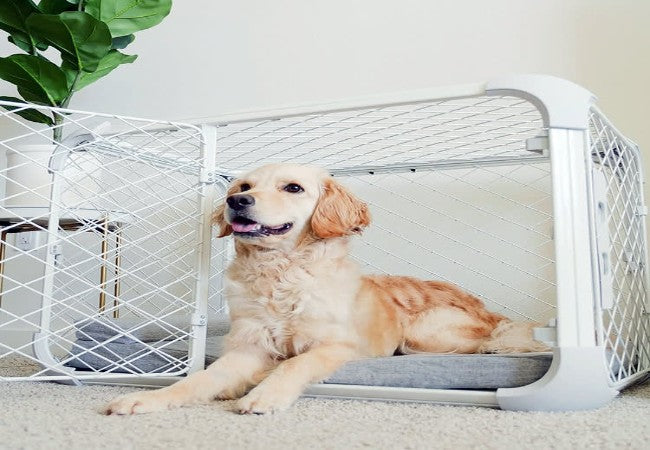Crate Training Puppies 2025: Vet Approved Safety & Comfort Guide 🐶

In this article
Crate Training Puppies 2025: Vet Approved Safety & Comfort Guide 🐶
By Dr. Duncan Houston BVSc
🔎 Why Crate‑Training Matters
Crate training offers puppies a safe “den” to retreat, supporting house-training, preventing destructive behaviors, easing anxiety, and making travel or vet visits less stressful. When introduced positively, it's a reliable tool and a home haven for your dog.
🧩 Choosing the Right Crate
- Proper size: Enough room to stand, turn, lie down—but not too large (avoid using one corner as a toilet).
- Type: Wire = ventilation/visibility; plastic = cozy travel; soft-sided = light & portable.
- Durability & cleaning: Rounded corners, sturdy build, easy to clean—metal and plastic preferred.
- Location: Place in a cozy family area—avoid isolated rooms or rigs near heat/cold.
- Comfort inside: Blanket or bed (if chew-safe), chew toys, scented cloth from home.
🐾 Step‑by‑Step Crate Training Plan
1. Make the Crate Inviting
Leave the door open initially; sprinkle treats inside and talk in a happy tone.
- Don’t force entry—allow free exploration.
- Feed meals near or inside the crate, gradually moving bowls deeper in.
2. Introduce Short, Positive Sessions
Once the puppy enters happily, close the door for a minute after eating. Gradually increase time while staying nearby. If whining starts, shorten the session.
3. Practice Leaving the Room
Stay quiet and calm when entering or exiting the crate. Step out briefly, then return calmly—reduce shock to their routine.
4. Gradually Be Away
Once your pup’s comfortable, begin leaving the house for increasing short periods (5–10 minutes), ensuring proper potty breaks first.
5. Overnight Crating
Crate in your bedroom initially—reduce stress by proximity. Provide a bedtime chew. Use the “age + 1 = hours” rule to determine potty holding times.
⏰ Crate-Time Limits by Age
- Up to 8 weeks: Very short periods—30–60 mins.
- 9–14 weeks: 1–3 hours max including sleep & breaks.
- 15–16 weeks: 3–4 hours.
- >17 weeks: 4–6 hours, with shorter holds at bedtime.
Over-crating risks soiling and emotional strain.
🧠 Troubleshooting Common Issues
Crying or Whining
- Differentiate frustration vs bathroom signals; respond only to the latter.
- Distract with a soft knock before responding—avoid reinforcing crying.
Anxiety & Escape Attempts
- Introduce more gradually, stay nearby, increase crate positivity.
- If prolonged vocalizing or chewing occurs, consult your vet or trainer.
Night-Time Soiling
- Usually puppy needs a middle-of-night break—be prepared to calmly let them out.
🎯 Benefits of Successful Crate Training
- ✔️ Easier house-training by leveraging den instincts.
- ✔️ Safe containment prevents chewing & accidents when unsupervised.
- ✔️ Encourages independence and self-soothing during stress.
- ✔️ Builds calm routines beneficial for travel, vet visits, boarding.
📅 Sample Daily Routine
- 7 am: Potty → Short supervised crate with chew toy
- 7:30: Breakfast in/near crate → crate session ~15 min
- 7:45: Potty → play/exercise
- 9 am: Longer crate time (30–60 min); owner in home
- 10 am: Potty → supervised time out of crate
- 12 pm: Lunch & crate session → play → crate (45 min)
- 3 pm: Potty → evening playtime
- 5 pm: Dinner + crate session → short absence
- 7 pm: Evening outing/play, then quiet crate time
- 9 pm: Last potty → crate in bedroom for night
🧰 Dr Houston’s Crate‑Training Checklist
- 🔹 Right-sized crate with comfort & chew toys
- 🔹 Open-door introduction with treat rewards
- 🔹 Gradual increase of time when alone
- 🔹 Calm exits and returns to avoid stress
- 🔹 Night crate in your bedroom for reassurance
- 🔹 Potty before crate; age-based holding times
- 🔹 Watch for anxiety—adjust pace as needed
- 📱 Use Ask A Vet for help troubleshooting any issues anytime
🌟 Final Thoughts
Crate training is a foundation for confident, well-adjusted puppies. When implemented gently, it supports potty training, reduces stress, and provides a personal haven. With patience and positive steps, you’ll teach your puppy to see their crate as a safe, comforting space—setting them up for lifelong emotional success. 🐶❤️
Need personalized crate-training help or behavior advice? Reach out via AskAVet.com or download the Ask A Vet app—veterinary support is just a click away. 📱🐾






